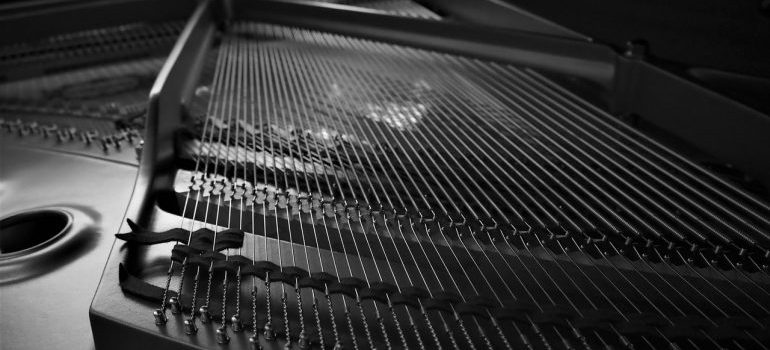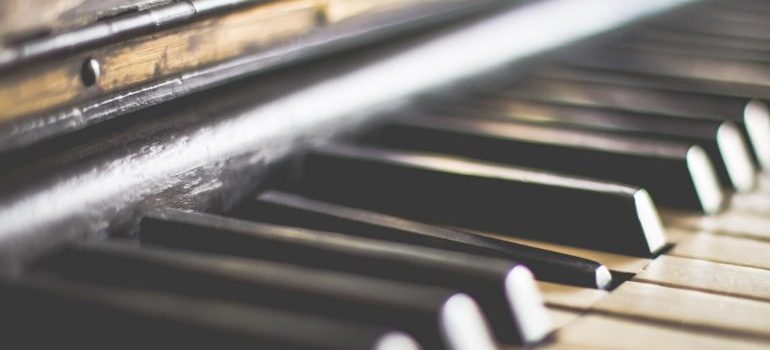How to inspect your piano before the move?
As one of the finest moving companies NYC, we provide you with a seamless relocation experience!
GET A FREE QUOTE
A piano is very expensive to buy, but also maintain. Most piano players and rich people can afford a professional to maintain your piano. But what about you? A regular person. How to inspect your piano before the move? Just looking at the piano and searching for scratches won’t make it. For that reason, we have decided to give you some tips that our full service movers NYC use when checking the piano. Obviously, you’ll need to be very careful when inspecting. A piano is full of parts that are more or less fragile. That’s why you need to proceed with caution and don’t ruin a perfectly working piano.
Open your piano up to inspect it before the move
It may sound scary, but if you want to really check your piano you’ll need to open it up. As it is so massive and so delicate at the same time we recommend you to have a second person help you with it. Also when putting parts away, and here’s a tip from our piano movers NJ, have them sorted out. Every little screw counts so you’ll need to take care when dismantling it so you can put it back as it was.

Grand piano
A grand piano doesn’t really look too much tricky to open up, but there are parts you’ll need to take extra care with. Firstly, take care of the lid, but be sure it’s attached nicely as it can fall down and get damaged. After that remove the music desk which is usually held together with screws on the side. The fallboard is up next which might help you, but isn’t vital to you looking your piano up so if you’re not sure maybe it’s best to leave it in place. In the end, there are key slips that are mostly being held by six screws under the. Be very careful when you move them back as every single one needs to fit its former place.
Vertical piano
Opening a vertical piano might seem harder, but it has a couple of parts that are important to get rid of so you can inspect your piano. firstly, get rid of the hinge pins as they are holding the lid. When you’ve taken off the lid the next on your plan should be the music shelf. They at times just come off and on other pianos, you’ll need to take off the screws.
Play some music to inspect your piano before the move
As silly as it sounds, play some music. It might take your mind off packing and other stressful aspects of moving. Get a piece of paper and write down anything that you think might sound off so you can check it later. This is a great occasion for you to put your piano playing skills to the test.

Tuning
How does your piano sound when you play it? If some of the notes are not smooth it might be a bad sign. When was your piano tuned last time? Pianos that stay untuned for years sometimes lose some of their smooth sounds.
Strings
Some of your strings are rusty, what now? Well, that is a common occurrence. A far worse problem for you is a mixture of new and rusty strings. This is usually a sign of string breakage. Watch out the next time you are tuning your piano as it can damage them even more.
Keys
There are different types of keys. Usually ivory and plastic ones for your everyday home piano. If they have some small damages it’s still not a big deal as long as they have their functionality. The biggest problem you can have with the keys is if they wiggle. If some of the keys are damaged don’t worry it’s the least expensive repair you can do on a piano.

Hammers
As small as they seem hammers are extremely important and can show you a lot about what condition the piano is in. Every single one of them has three grooves that hit the strings. If some of the hammers have damaged grooves then you’ll need a fix sooner rather than later.
Pedals
On vertical pianos, the pedal often has some minor damages or has some parts missing. These types of pianos have rarely pedal problems. On the other hand, pedals on a grand piano are far more complex. These types of damages can become pricey but you need to inspect them before the move.
Inspect the structural integrity of your piano before the move
Before the move, you’ll need to take a good look before it’s time for your piano to hit the road. Some scratches and damages have less and others more of an impact on your instrument. Especially if your piano was inside some storage space and was there for some time. You’ll need to have everything checked out. From the legs that sometimes crack or wiggle and can be repaired easily, to beams and the plate that if damaged can ruin completely a piano.
Call a professional to inspect your piano before the move
In the end, the best thing is to hire a professional. It costs money but you are sure everything will be thoroughly checked. You and whoever will help you can take a look at the inside, but it takes a true master to recognize all the problems an instrument can have. It’s something people do only in these types of events so giving some money away isn’t a waste.
Moving a piano is always difficult and using professionals is the best option. Even though it comes at a steep price you’ll be sure everything goes smooth. For that reason, let us hope that our tips on how to inspect your piano before the move. As so many of them come with such a steep price tag, here are the most expensive pianos we could find so you can imagine the stress of moving such pieces of art. Good look with your move!
